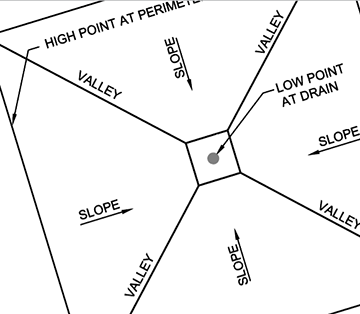
A frequent question NRCA’s Technical Services staff receives is: How is the R-value of a tapered insulation system determined for code-compliance purposes? Although the International Energy Conservation Code® provides some guidance, the answer depends on the edition of the energy code that applies to the project.
IECC 2018 and previous editions
Up to and including IECC 2018, above-roof deck tapered roof insulation only had been addressed vaguely.
IECC 2018, Exception 1 to Section C402.2.1-Roof Assembly indicates that where insulation thickness varies by 1 inch or less, an area-weighted U-factor is equivalent to the same assembly with the minimum R-value required by the code. In IECC 2015 and 2018, an additional statement indicates this also is intended to address above-roof deck tapered insulation.
The code’s commentary provides some useful information for interpreting and using this exception. The 2018 IECC Code and Commentary explains when this exception is applied, the variation in tapered insulation thickness for energy code compliance purposes is limited to 1 inch. This 1-inch limitation does not prevent the provision from being applied to tapered insulation systems that have greater variations; it simply does not allow additional insulation thickness to be factored into the average insulation calculation.
For example, if the thickness variation of a tapered insulation system exceeds 1 inch, it is permissible to determine the R-value at the low point. But the R-value also should be determined where the tapered insulation thickness is 1 inch thicker than the low point. The remaining portions of the roof would be assumed to have the same R-value as the area-weighted R-value for the roof.
Based on this example, for a ¼-inch-per-foot tapered insulation system, the tapered insulation will be 1 inch thicker 4 feet away from the low point. The remaining thickness of tapered insulation provides no benefit for energy code compliance purposes.
IECC 2021
In IECC 2021, the code’s requirements for addressing R-values of tapered insulation systems changed.
IECC 2021’s Section C402.2.1.1-Tapered, Above-Deck Insulation Based on Thickness indicates when tapered insulation is used as a component of a roof-ceiling assembly R-value calculation, the tapered insulation’s R-value contribution to that calculation must use the average thickness in inches along with the material R-value per inch to comply with the minimum R-value required by the code.
Section C402.2.1.2-Minimum Thickness, Low Point indicates the minimum thickness of above-deck roof insulation at its lowest point, gutter edge, roof drain or scupper must be not less than 1 inch.
IECC 2021’s new approach allows building owners to take advantage of the added energy efficiency of tapered insulation beyond the “1 inch thicker than the low point” prescriptive requirement in the code’s previous editions.
In some instances, this new approach may allow for the use of less flat-stock fill material beneath tapered insulation systems to achieve the code’s minimum R-value requirements.
NRCA was the proponent of the code change proposal that allows the use of the average R-value method.
Closing thoughts
The method for determining the R-value of tapered insulation systems for energy code compliance depends on the specific edition of the energy code that applies to the project.
Although the method prescribed in IECC 2018 and previous editions was ambiguous and often difficult to interpret, the new method in IECC 2021 is clearer and easier to understand. It is also how most tapered insulation suppliers report R-values on their drawings.
For IECC 2024, which has not yet been finalized, the average R-value method will remain for tapered insulation systems with some minor rewording and reformatting. Also, a clarifying statement is proposed indicating the average thickness of roof insulation should be equal to the total volume of the roof insulation divided by the roof’s area. This often is referred to as the “volumetric method.”
Additional information about tapered insulation systems for use in low-slope membrane roof systems is provided in The NRCA Roofing Manual: Membrane Roof Systems—2019 , Chapter 4-Rigid Board Insulation, Section 4.14-Tapered Insulation, pages 158-169.
MARK S. GRAHAM is NRCA’s vice president of technical services.
This column is part of Research + Tech. Click here to read additional stories from this section.



